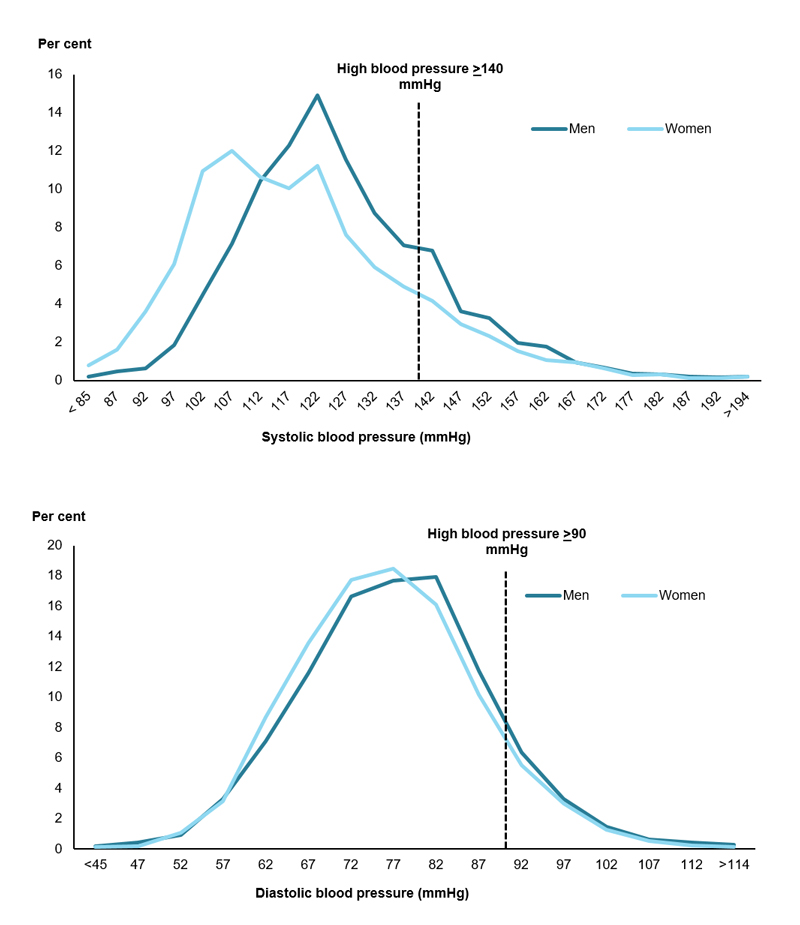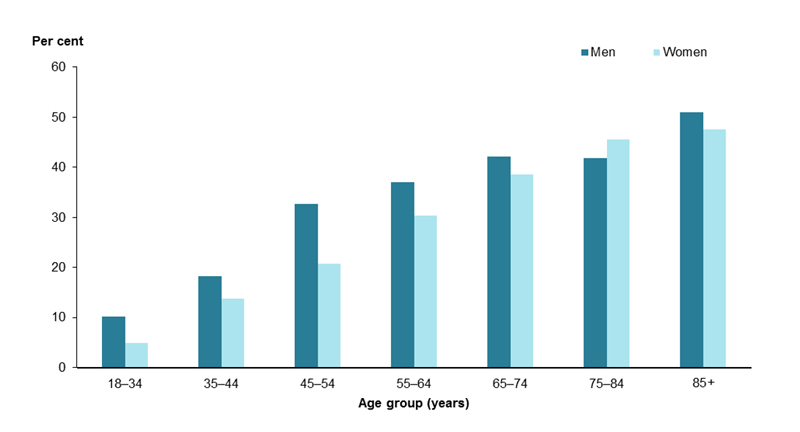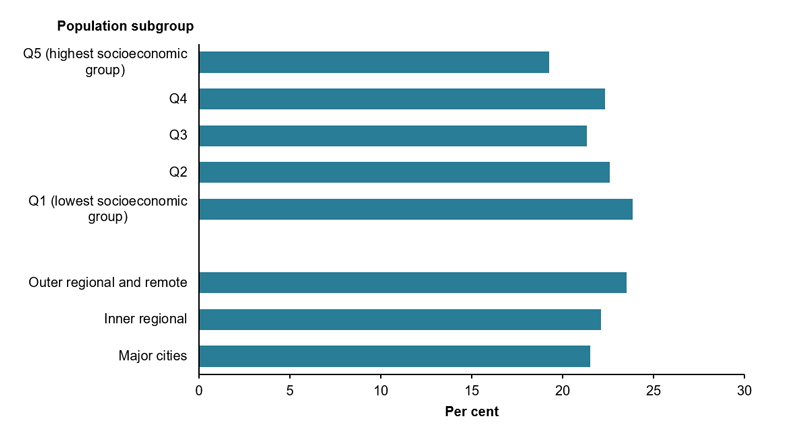High blood pressure
High blood pressure – also known as hypertension – is a major risk factor for chronic conditions including stroke, coronary heart disease, heart failure and chronic kidney disease (see heart stroke and vascular disease and chronic kidney disease for more information). In 2015, 5.8% of the total burden of disease in Australia was due to high blood pressure (AIHW 2019). About 21% of high blood pressure burden in Australia in 2015 is due to a diet high in sodium – higher for men (23%) than women (17%) – based on unpublished estimates from the Australian Burden of Disease Study (ABDS) (see Burden of disease). The ABDS 2015 estimated how much impact a diet high in sodium had on blood pressure levels in Australia using a risk factor causing a risk factor approach. In addition to high salt intake, other risk factors for high blood pressure include poor diet, obesity, excessive alcohol consumption and insufficient physical activity. High blood pressure can be controlled with lifestyle measures and medication, reducing the risk of developing chronic conditions.
Box 1: How is high blood pressure measured?
Blood pressure is the force exerted by the blood on the walls of the arteries and is written as systolic/diastolic (e.g. 120/80 mmHg, stated as '120 over 80').
The World Health Organization defines high blood pressure as including any of the following:
- systolic blood pressure greater than or equal to 140 mmHg, or
- diastolic blood pressure greater than or equal to 90 mmHg, or
- receiving medication for high blood pressure (Whitworth 2003).
The Australian Bureau of Statistics (ABS) National Health Survey 2017–18 measured blood pressure at the time of the interview, and the definitions listed above were used in defining high blood pressure in the results presented here. 'Uncontrolled high blood pressure' is defined as measured systolic blood pressure of 140 mmHg or more, or diastolic blood pressure of 90 mmHg or more, whether or not they were taking blood pressure medication (ABS 2018). Controlled blood pressure refers to those people who are taking blood pressure medication and have a normal blood pressure reading.
Who has high blood pressure?
Based on measured data from the 2017–18 Australian Bureau of Statistics National Health Survey, about 1 in 3 people aged 18 and over (34%) have high blood pressure.
This comprises:
- 23% with uncontrolled high blood pressure; and
- 11% whose blood pressure was controlled using medication/s (Table S1 ).
There has been no change in the prevalence of uncontrolled high blood pressure since 2011–12 (ABS 2018a).
Men are more likely to have uncontrolled high blood pressure than women. In particular, 1 in 4 men (25%) had uncontrolled high blood pressure compared with 1 in 5 (20%) women.
The average systolic blood pressure is higher for men (126 mmHg) than for women (119 mmHg). The average diastolic blood pressures are similar for men and women (77 and 76 mmHg) (Figure 1).
Figure 1: Prevalence distribution of systolic and diastolic blood pressure measurements, 2017–18

Note: Measured high blood pressure excludes self-reported hypertension prevalence rates. In 2017-18, 31.6% of respondents aged 18 years and over did not have their blood pressure measured. For these respondents, imputation was used to obtain blood pressure. For more information see Appendix 2: Physical measurements in the National Health Survey.
Source: AIHW analysis of ABS 2019. (see Table S3 for footnotes).
The proportion of adults with uncontrolled high blood pressure increased with age―from 10% or less among 18–34 year-olds (10% for men and 4.9% for women) to a peak of 47% at age 85 and over (51% for men and 48% for women).
Figure 2: Prevalence of uncontrolled high blood pressure among adults, by age and sex, 2017–18

Source: ABS 2018a: AIHW analysis of ABS 2019 (see Table S2 for footnotes).
Inequalities
The prevalence of uncontrolled high blood pressure is similar between remoteness areas (Figure 3).
- 24% for Outer regional and remote areas
- 22% for Inner regional areas
- 22% for Major cities
Uncontrolled high blood pressure is significantly more common in the lowest socioeconomic areas where 1 in 4 people (24%) have uncontrolled high blood pressure, compared with 1 in 5 (19%) people in the highest socioeconomic areas (Figure 3).
Figure 3: Prevalence of uncontrolled high blood pressure among adults, by socioeconomic areas and remoteness, 2017–18

Source: AIHW analysis of ABS 2019 (see Table S4 for footnotes).
International comparisons
Age-standardised data from the World Health Organization reported that an estimated 18% of men and 12% of women aged 18 and over in Australia had uncontrolled high blood pressure in 2015 (based on systolic blood pressure and diastolic blood pressure only). These estimates differ to the data presented above as they have been standardised to the global population in order to make comparisons between countries (WHO 2015). This was a lower proportion than most other OECD countries (Organisation for Economic Cooperation and Development), and lower than the average across the 36 OECD countries (25% for men and 16% for women).
The Republic of Korea had the lowest proportion (14% for men and 8% for women) followed by the United States of America (15% for men and 11% for women) and then Canada (16% for men and 11% for women). While Lithuania, Latvia, Hungary and Slovenia had the highest rates of raised blood pressure (36% for men and between 23-25% for women).
Source data
ABS 2018a. National Health Survey: First Results, 2017-18. ABS cat. no. 4364.0.55.001. Canberra: Australian Bureau of Statistics.
ABS 2018b. Census of Population and Housing: Socio-Economic Indexes for Areas (SEIFA). ABS cat. no. 2033.0.55.001. Canberra: Australian Bureau of Statistics.
ABS 2018c. Australian Statistical Geography Standard (ASGS): Volume 5 - Remoteness Structure, July 2016. ABS cat. no. 1270.0.55.005. Canberra: Australian Bureau of Statistics.
ABS 2019. Microdata: National Health Survey 2017–18. ABS cat. no. 4324.0.55.001. Canberra: Australian Bureau of Statistics. Findings based on AIHW analysis of ABS microdata.
Australian Institute of Health and Welfare 2019. Australian Burden of Disease Study: impact and causes of illness and death in Australia 2015. Australian Burden of Disease series no. 19. Cat. no. BOD 22. Canberra: AIHW.
Whitworth JA 2003. 2003 World Health Organization/International Society of Hypertension statement on management of hypertension. Journal of Hypertension 21:1983-92.
WHO (World Health Organization) 2015. WHO global health observatory data repository. Raised blood pressure (SBP ≥ 140 OR DBP ≥ 90). Date by country. Geneva: World Health Organization. Viewed 24 January 2019.


